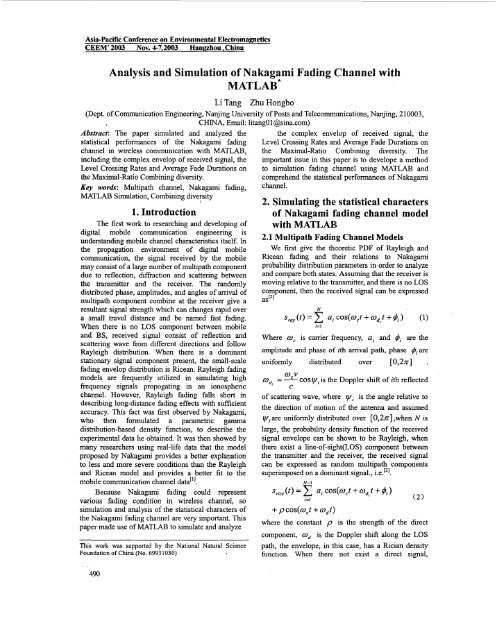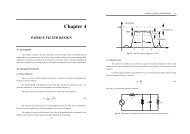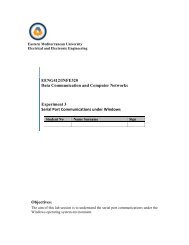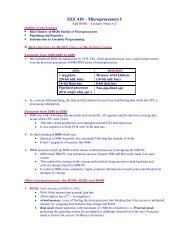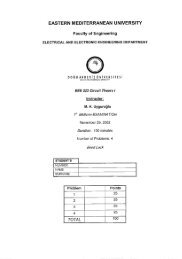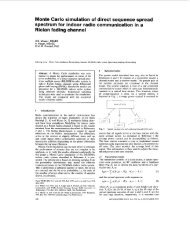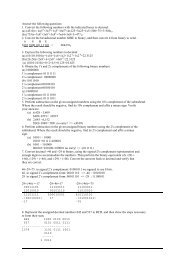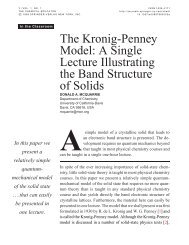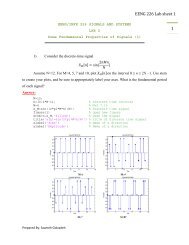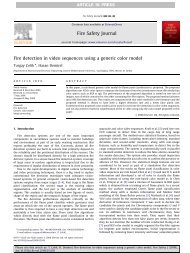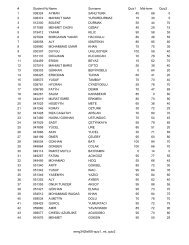Analysis and simulation of nakagami fading channel with ... - faraday
Analysis and simulation of nakagami fading channel with ... - faraday
Analysis and simulation of nakagami fading channel with ... - faraday
Create successful ePaper yourself
Turn your PDF publications into a flip-book with our unique Google optimized e-Paper software.
<strong>Analysis</strong> <strong>and</strong> Simulation <strong>of</strong> Nakagami Fading Channel <strong>with</strong>MATLAB*Li Tang Zhu Hongbo(Dept. <strong>of</strong> Communication Engineering, Nanjing University <strong>of</strong> Posts <strong>and</strong> Telecommunications, Nanjing, 210003,CHINA, Email: litango1 @sina.com)Abstract: The paper simulated <strong>and</strong> analyzed thestatistical perfomances <strong>of</strong> the Nakagami <strong>fading</strong><strong>channel</strong> in wireless communication <strong>with</strong> MATLAB,including the complex envelop <strong>of</strong> received signal, theLevel Crossing Rates <strong>and</strong> Average Fade Durations onthe Maximal-Ratio Combining diversity.Key words: Multipath <strong>channel</strong>, Nakagami <strong>fading</strong>,MATLAB Simulation, Combining diversity1. IntroductionThe first work to researching <strong>and</strong> developing <strong>of</strong>digital mobile communication engineering isunderst<strong>and</strong>ing mobile <strong>channel</strong> characteristics itself. Inthe propagation environment <strong>of</strong> digital mobilecommunication, the signal received by the mobilemay consist <strong>of</strong> a large number <strong>of</strong> multipath componentdue to reflection, diffkaction <strong>and</strong> scattering betweenthe transmitter <strong>and</strong> the receiver. The r<strong>and</strong>omlydistributed phase, amplitudes, <strong>and</strong> angles <strong>of</strong> arrival <strong>of</strong>multipath component combine at the receiver give aresultant signal strength which can changes rapid overa small travel distance <strong>and</strong> be named fast <strong>fading</strong>.When there is no LOS component between mobile<strong>and</strong> BS, received signal consist <strong>of</strong> reflection <strong>and</strong>scattering wave from different directions <strong>and</strong> followRayleigh distribution. When there is a dominantstationary signal component present, the small-scale<strong>fading</strong> envelop distribution is Ricean. Rayleigh <strong>fading</strong>models are frequently utilized in simulating highfrequency signals propogating in an ionospheric<strong>channel</strong>. However, Rayleigh <strong>fading</strong> falls short indescribing long-distance <strong>fading</strong> effects <strong>with</strong> sufficientaccuracy. This fact was first observed by Nakagami,who then formulated a parametric gammadistribution-based density function, to describe theexperimental data he obtained. It was then showed bymany researchers using real-life data that the modelproposed by Nakagami provides a better explanationto less <strong>and</strong> more severe conditions than the Rayleigh<strong>and</strong> Ricean model <strong>and</strong> provides a better fit to themobile communication <strong>channel</strong> data['].Because Nakagami <strong>fading</strong> could representvarious <strong>fading</strong> condition in wireless <strong>channel</strong>, so<strong>simulation</strong> <strong>and</strong> analysis <strong>of</strong> the statistical characters <strong>of</strong>the Nakagami <strong>fading</strong> <strong>channel</strong> are very important. Thispaper made use <strong>of</strong> MATLAB to simulate <strong>and</strong> analyzeThis work was supported by the National Natural ScienceFoundation <strong>of</strong> China (No. 6993 1030)490the complex envelop <strong>of</strong> received signal, theLevel Crossing Rates arid Average Fade Durations onthe Maximal-Ratio Combining diversity. Theimportant issue in this paper is to develope a methodto <strong>simulation</strong> <strong>fading</strong> <strong>channel</strong> using MATLAB <strong>and</strong>comprehend the statistical performances <strong>of</strong> Nakagami<strong>channel</strong>.2. Simulating the statistical characters<strong>of</strong> Nakagami <strong>fading</strong> <strong>channel</strong> model<strong>with</strong> MATLAB;2.1 Multipath Fading Channel ModelsWe first give the theoretic PDF <strong>of</strong> Rayleigh <strong>and</strong>hcean <strong>fading</strong> <strong>and</strong> their relations to Nakagamiprobability distribution parameters in order to analyze<strong>and</strong> compare both states. Assuming that the receiver ismoving relative to the transmitter, <strong>and</strong> there is no LOScomponent, then the received signal can be expressedsr,y ('1 =Ni=lai ~ ~ ~ ( + u~ cd t t + , #i) (1)Where W, is carrier fiequency, ai <strong>and</strong> #; are theamplitude <strong>and</strong> phase <strong>of</strong> ith arrival path, phase #iareuniformly distributed over [072z] .W Vw,, = C COS viis the Doppler shift <strong>of</strong> ith reflectedC<strong>of</strong> scattering wave, where vi is the angle relative tothe direction <strong>of</strong> motion <strong>of</strong> the antenna <strong>and</strong> assumedare uniformly distributed over [O72z],when N isvilarge, the probability density function <strong>of</strong> the receivedsignal envelope can be shown to be Rayleigh, whenthere exist a line-<strong>of</strong>-sight(L0S) component betweenthe transmitter <strong>and</strong> the receiver, the received signalcan be expressed as r<strong>and</strong>om multipath componentssuperimposed on a domnant signal., i.e.[21.+ p COS(W,t 4- W,t]where the constant p is the strength <strong>of</strong> the directcomponent, W, is the Doppler shift along the LOSpath, the envelope, in this case, has a kcian densityfunction. When there not exist a direct signal,
Typical simdated <strong>nakagami</strong> lading <strong>of</strong> me camer Receiver speed=80!un%I0.5 1 1.5Vsecfig.2 Simulating received signal envelop when m=1.5(corresponding to Rician distribution) ,a 7 r,/dtI)fig.6 Normalized LCR f!)r m=0.6 ( m=1.5, <strong>with</strong> diversityorders L= 1,2,3,4,10Twical simulated <strong>nakagami</strong> lading <strong>of</strong> me canier Receiver s peed=M3020-20.I4 05 1 15Vsecfig.3 Simulated received signal envelop when m=10(light shadow <strong>fading</strong>)C F rJdB)fig.7 Normalized AFD for m=0.6 <strong>with</strong> diversiy ordersL=l,2,3,4,5fig.4 Normalized LCR for m=0.6 <strong>with</strong> diversity ordersL=l,2,3,4,10fig.8 Normalized AFD for m=l <strong>with</strong> diversiy ordersL==l,2,3,4,5IO''E3fig.5IT rJdtI)Normalized LCR for m=l<strong>with</strong> diversity ordersL=l,2,3,4,10fig.9Normalized AFD for m=l.5 <strong>with</strong> diversity ordersLa= 1,2,3,4494


